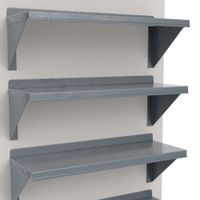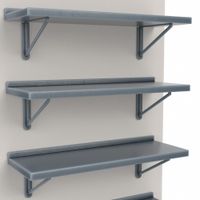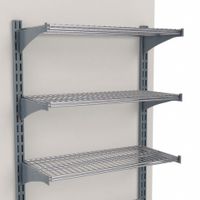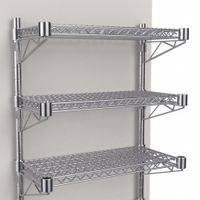Call +(254) 703 030 000 / 751 483 999 / 721 704 777
- Home
- Material Handling
- Storage Workspace
- Shelving Storage Racks
- Wall Mount Shelving Overhead Racks
.....Read More
Frequently Asked Questions
What is the weight capacity of wall-mount shelving and overhead racks?
The weight capacity of wall-mount shelving and overhead racks varies significantly based on several factors, including the materials used, the design, the installation method, and the manufacturer's specifications.
1. **Wall-Mount Shelving:**
- **Material and Design:** Shelves made from heavy-duty materials like steel or reinforced wood can typically support more weight than those made from plastic or lightweight wood.
- **Brackets and Supports:** The type and number of brackets used can affect capacity. Heavy-duty brackets can support more weight, and additional brackets can distribute weight more evenly.
- **Installation:** Proper installation into wall studs or using appropriate anchors is crucial. Shelves mounted directly into studs can generally support more weight than those using drywall anchors.
- **Typical Capacity:** Generally, wall-mounted shelves can support anywhere from 50 to 300 pounds per shelf, depending on the above factors.
2. **Overhead Racks:**
- **Material and Construction:** Overhead racks are often made from steel and are designed to hold heavier loads. The gauge of the steel and the design (e.g., grid or solid) can influence capacity.
- **Mounting System:** These racks are usually mounted to ceiling joists, which can support significant weight if properly installed.
- **Typical Capacity:** Overhead racks can typically support between 250 to 600 pounds, with some heavy-duty models supporting up to 1,000 pounds or more.
Always refer to the manufacturer's guidelines for specific weight limits and ensure proper installation to maximize safety and performance.
How do I install wall-mount shelving and overhead racks?
1. **Plan and Measure**: Determine the location and purpose of the shelving and racks. Measure the wall space and ceiling height to ensure proper fit.
2. **Select Materials**: Choose sturdy materials like metal or heavy-duty wood for durability. Ensure brackets and supports can handle the intended weight.
3. **Gather Tools**: You’ll need a drill, level, stud finder, tape measure, pencil, screws, anchors, and a screwdriver.
4. **Locate Studs**: Use a stud finder to locate wall studs for wall-mounted shelves and ceiling joists for overhead racks. Mark their positions with a pencil.
5. **Mark and Drill**: For wall shelves, mark the desired height and use a level to draw a straight line. For overhead racks, mark the ceiling where the joists are located. Drill pilot holes into the studs or joists.
6. **Install Brackets**: Attach the brackets to the wall or ceiling using screws. Ensure they are level and securely fastened into the studs or joists.
7. **Mount Shelves/Racks**: Place the shelves onto the wall brackets or attach the overhead racks to the ceiling brackets. Secure them with screws.
8. **Check Stability**: Ensure everything is level and securely fastened. Test the stability by applying pressure or placing a small weight on the shelves/racks.
9. **Organize**: Arrange items on the shelves and racks, distributing weight evenly to prevent sagging or damage.
10. **Safety Check**: Regularly inspect the installation for any signs of wear or loosening, especially if storing heavy items. Adjust or reinforce as necessary.
What materials are best for wall-mount shelving and overhead racks?
For wall-mount shelving, the best materials include:
1. **Wood**: Offers a classic look and is versatile. Solid wood like oak or maple is durable, while plywood is cost-effective.
2. **Metal**: Steel or aluminum provides strength and a modern aesthetic. Ideal for heavy-duty storage.
3. **MDF (Medium-Density Fiberboard)**: Affordable and smooth, suitable for painted finishes but less durable than solid wood.
4. **Glass**: Provides a sleek, contemporary look, best for decorative shelving rather than heavy storage.
For overhead racks, the best materials are:
1. **Steel**: Offers maximum strength and durability, essential for supporting heavy loads. Powder-coated steel resists rust and corrosion.
2. **Aluminum**: Lightweight yet strong, suitable for moderate loads and easier installation.
3. **Wire Mesh**: Often used in combination with steel frames, allows for visibility and air circulation, preventing dust accumulation.
Both applications benefit from materials that are durable, easy to maintain, and appropriate for the intended load and aesthetic.
Can wall-mount shelving and overhead racks be used in damp or humid environments?
Yes, wall-mount shelving and overhead racks can be used in damp or humid environments, but certain considerations must be taken into account to ensure durability and functionality.
1. **Material Selection**: Choose materials that are resistant to moisture and corrosion. Stainless steel, powder-coated metal, and certain plastics like PVC or polypropylene are ideal as they resist rust and degradation. Avoid materials like untreated wood or regular steel, which can warp or corrode.
2. **Coatings and Finishes**: Opt for shelving and racks with protective coatings. Galvanized or powder-coated finishes provide an extra layer of protection against moisture. These coatings prevent rust and extend the lifespan of the shelving.
3. **Design and Construction**: Ensure the design allows for proper air circulation. Open wire shelving is preferable as it permits airflow, reducing moisture buildup and preventing mold and mildew growth.
4. **Installation Considerations**: Use corrosion-resistant hardware for installation. Stainless steel screws and brackets are recommended to prevent rust. Ensure that the installation is secure to handle the weight and potential expansion or contraction due to humidity.
5. **Maintenance**: Regular maintenance is crucial. Clean the shelves and racks periodically to remove any moisture or debris. Inspect for signs of rust or damage and address them promptly.
6. **Environmental Control**: If possible, control the environment by using dehumidifiers or ventilation systems to reduce humidity levels. This will help in maintaining the integrity of the shelving and racks.
By selecting the right materials and taking appropriate precautions, wall-mount shelving and overhead racks can be effectively used in damp or humid environments without compromising their structural integrity or functionality.
How do I choose the right size and type of shelving for my space?
1. **Assess Your Space**: Measure the dimensions of the area where you plan to install shelving. Consider ceiling height, wall width, and depth to ensure the shelves fit comfortably without obstructing movement or other furniture.
2. **Determine Purpose**: Identify what you will store. Books, decorative items, or heavy tools require different shelving types. This will influence the material and strength needed.
3. **Choose Material**: Select materials based on aesthetics and durability. Wood offers a classic look, metal provides industrial strength, and glass adds a modern touch. Consider the weight capacity of each material.
4. **Consider Style**: Match the shelving style with your room’s decor. Floating shelves offer a minimalist look, while built-in shelves provide a seamless integration. Freestanding units are versatile and can be moved easily.
5. **Evaluate Load Capacity**: Ensure the shelves can support the weight of the items you plan to store. Check manufacturer specifications for weight limits.
6. **Accessibility**: Consider how often you need to access the items. Adjustable shelves offer flexibility for changing needs, while fixed shelves provide stability.
7. **Budget**: Determine your budget. Custom shelving can be expensive, while ready-made options are more affordable. Balance cost with quality and longevity.
8. **Installation**: Decide if you will install the shelves yourself or hire a professional. Some shelving systems are easy to install, while others may require expertise.
9. **Safety**: Ensure shelves are securely anchored to prevent tipping, especially in homes with children or pets.
10. **Future Needs**: Consider potential future changes in storage needs or room function, and choose shelving that can adapt or be expanded.
Are there adjustable options for wall-mount shelving and overhead racks?
Yes, there are adjustable options for wall-mount shelving and overhead racks. Many manufacturers offer systems that allow for customization in terms of height, width, and depth to accommodate different storage needs and space constraints.
For wall-mount shelving, adjustable brackets and tracks are commonly used. These systems often include slotted standards or rails that are mounted to the wall, allowing shelves to be repositioned at various heights. This flexibility is ideal for changing storage needs or for accommodating items of different sizes. Some systems also offer adjustable shelf depths and widths, providing further customization.
Overhead racks, often used in garages or storage rooms, also come with adjustable features. These racks can typically be adjusted in height to maximize vertical space and ensure clearance for vehicles or other items below. Some systems allow for the adjustment of the rack's width and length, making it possible to fit into various ceiling spaces or to expand as storage needs grow.
Both wall-mount shelving and overhead racks may include additional accessories such as hooks, baskets, or bins that can be repositioned or added to enhance functionality. These systems are designed to be versatile and adaptable, making them suitable for a wide range of applications, from residential to commercial settings.
What are the safety considerations when installing overhead racks?
1. **Weight Capacity**: Ensure the overhead rack is rated for the weight you intend to store. Overloading can lead to structural failure.
2. **Installation Location**: Choose a location with sufficient clearance from walls, doors, and other obstructions. Ensure the ceiling can support the rack and its load.
3. **Ceiling Structure**: Verify that the ceiling is structurally sound and capable of supporting the rack. Use joists or beams for secure anchoring.
4. **Anchoring**: Use appropriate hardware, such as lag bolts or screws, to securely attach the rack to the ceiling joists. Avoid using drywall anchors alone.
5. **Rack Material**: Select racks made from durable materials like steel, which can withstand heavy loads and resist corrosion.
6. **Load Distribution**: Evenly distribute weight across the rack to prevent tipping or sagging. Avoid placing heavy items on one side.
7. **Height and Accessibility**: Install racks at a height that allows safe access. Use ladders or step stools with caution to prevent falls.
8. **Clearance**: Maintain adequate clearance from electrical wiring, plumbing, and HVAC systems to prevent damage or interference.
9. **Regular Inspection**: Periodically check the rack for signs of wear, rust, or damage. Tighten any loose hardware and replace damaged components.
10. **Safety Labels**: Follow manufacturer instructions and safety labels regarding weight limits and installation procedures.
11. **Professional Installation**: Consider hiring a professional if unsure about installation requirements or if the ceiling structure is complex.
12. **Emergency Access**: Ensure stored items do not block emergency exits or access to essential utilities.
13. **Environmental Conditions**: Consider environmental factors like humidity and temperature, which may affect the rack's integrity over time.



